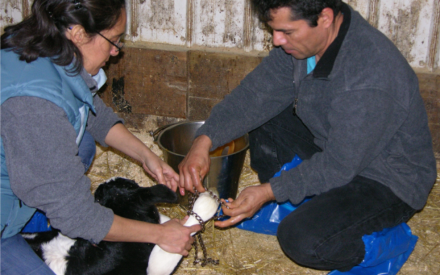English | Español

Introduction
In labor-intensive environments like farms and other agricultural operations, conflict between employees can happen. Conflict is friction—disagreement between two or more people. Our brains often perceive conflict as a threat, which makes it uncomfortable and leads many people to avoid it. But in high-stress, physical environments like farms, where long hours and high expectations are common, conflict is almost inevitable.
However, conflict doesn’t have to be a negative thing. When handled properly, it can lead to stronger communication, better teamwork, and long-term improvements and innovation.
Here’s what farm managers, supervisors, and team leaders need to know.
Why Does Conflict Happen on the Farm?
Workplace conflict usually doesn’t come out of nowhere. Understanding the root causes is the first step toward solving and preventing it.
Some of the most common sources of conflict on farms and other ag operations include:
- Poor communication: Misunderstandings about tasks or expectations can quickly escalate.
- Different work styles: Some people will approach and evaluate tasks differently and move fast, others would take more time to evaluate the different options. These differences can create tension.
- Unclear responsibilities: If roles and tasks aren’t clearly defined, it can lead to overlaps or confusion.
- Cultural or language barriers: Farms often have diverse teams. Without clear communication, even small differences can grow into conflict.
- Stress and fatigue: Long shifts and seasonal pressure can wear down patience and increase frustration.
- Generational differences: Age differences can cause conflict in the workplace as each generation has different values, goals and priorities.
What Happens When Conflict Is Ignored?
It’s easy to think a problem will go away on its own—but unresolved conflict usually gets worse, not better.
When supervisors avoid addressing tension, it can lead to:
- Low morale: Team members may become frustrated or feel unsupported.
- Productivity loss: People who are upset don’t work as efficiently.
- Turnover: Good employees may leave if they feel the environment is negative.
- Poor performance: Conflict distracts from the work and makes it harder to focus on quality and safety.
How to Manage Conflict Effectively
Dealing with conflict doesn’t have to be complicated—but it does take intention. Here’s how to handle it when issues arise:
Create a safe space to talk: Set aside time to meet privately with those involved before the conversation. To foster a safe and constructive environment, establish ground rules that encourage respectful behavior. These rules can include prohibiting personal attacks and ensuring that everyone has an equal amount of time to speak.
Listen to both sides: Stay calm and neutral. Let each person explain their point of view without interruption.
Find the root of the issue: Look beyond what happened on the surface and understand the real reason why this conflict started. We want to find the cause, not just the symptoms. For example, a disagreement about schedules might really be about feeling disrespected.
Focus on shared goals: Remind team members that everyone wants the same thing—a safe, respectful, productive workplace.
Agree on a plan: Talk through what changes need to happen, who’s responsible, and how you’ll follow up.
Bring in help if needed: If a situation keeps repeating or gets worse, involve a more experienced manager or an outside advisor.
The Leader’s Role in Managing Conflict
Farm managers and supervisors play a critical role in managing and resolving workplace conflict. When conflict is ignored, it can weaken leadership, as employees may view leaders who fail to take action as ineffective or unwilling to confront issues. Consider these practical strategies to prevent and manage issues effectively.
Lead by example: Stay calm under pressure and treat everyone with respect—even during tough conversations.
Be consistent and fair: Avoid favoritism. When people feel that everyone is treated equally, there’s less room for resentment or tension.
Communicate clearly: Make sure expectations, schedules, and responsibilities are understood by all team members.
Promote teamwork: Encourage employees to speak up, share ideas, and support one another.
Train your team leaders: If you have supervisors or crew leaders under you, give them the tools to handle small issues early—before they grow.
Check in regularly: Don’t wait for problems to come to you. Ask your team how things are going and listen carefully to what they say.
Conclusion
Conflict is a normal part of working with people, especially in high-pressure, hands-on industries like agriculture. When leaders respond with clarity, respect, and a focus on solutions, conflict becomes an opportunity for growth, not a threat to the team.

 First impressions matter: The importance of onboarding farm new hires
First impressions matter: The importance of onboarding farm new hires Effective Farm Safety Training Starts with a Purpose
Effective Farm Safety Training Starts with a Purpose ¿Refleja tu cultura quién quieres ser como empleador?
¿Refleja tu cultura quién quieres ser como empleador? Building a Positive Farm Business Culture: Characteristics of Latin/Hispanic dairy workers
Building a Positive Farm Business Culture: Characteristics of Latin/Hispanic dairy workers


